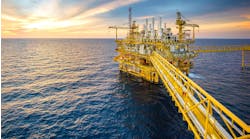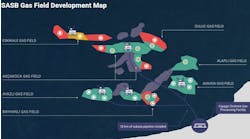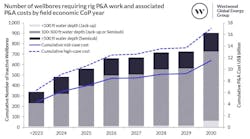By Greg Carter,Nautilus Offshore Company Inc.
ENSCO Rig 26 on ExxonMobile's Diana Hoover SPAR
The platform rig industry has found itself in a state of evolution. The role of these rigs is changing to meet the increasingly rigorous demands of deepwater applications, while preserving the role they play as a cost-effective solution. While the issues of safety and performance remain vital to the success of deepwater projects, other factors, including weight-reduction and critical design functions, are taking on increased importance, especially in the context of allowing the offshore exploration industry access to smaller reserves in deeper water.
Worst case
Offshore platform rigs play a crucial role in deepwater, dry-tree exploration, and development solutions. The applied forces of platform rigs and their associated components often represent the worst-case loading for a given floating host structure, such as tension leg platforms, Spars, and deep draft casson vessels. All components of a rig built with dynamic capabilities should be scrutinized and reconsidered in terms of different "what-if" scenarios. In many cases, the resourceful designer can identify numerous ways to remove, replace, re-engineer, or combine rig components, saving weight and footprint. The challenge is to move platform rig technology into deeper water. Minimizing weight in this way will help to position the deepwater offshore exploration industry for further economical reserve recovery by making smaller deep-water plays economic to develop.
Weight issues in deepwater projects
Dry weights for the various commercial platform rigs included in the following poster vary in accordance with their capacities. Because a platform rig must adapt to its host structure, the platform size and layout will influence rig component size, type, and configuration. Typical dry-weight loads applied by the larger 2,000 and 3,000 horsepower commercial platform rigs range from 2,000 to 5,000 kips. Dry weights for 600 to 1,500 horsepower rigs can vary from 350 to 2,500 kips, depending on whether the rig will be used for workover or drilling activities. The dry weights of these rigs may fall outside the ranges listed above when addition equipment is added. Possible options included more quarters, helidecks, cantilevered deck sections, cranes, tankage, and additional power capabilities. Associated live loads obviously depend on the operator's requirements, but can typically add an additional 3,000 to 6,000 kips or more to the total load.
Changes in platform rigs
Several changes have taken place in the commercial platform rig market. These changes have led to a net increase of known commercial platform rigs around the world by one for a total of 93. Helmerich and Payne added two platform rigs to their fleet; 2,000 horsepower Rig 205 and 1,500 horsepower Rig 206. Nabors Offshore Corp. added a new SuperSundowner XVIII to its fleet and is adding a new Modular Offshore Dynamic Series 150 series 1,500 horsepower platform rig. Pride converted its mechanically driven Rig 952 to the 1,000 horsepower Rig 1005E and added 1,000 horsepower electrically driven platform Rig 1006. Atwood's Rig 19 came off of the poster as no longer in service as did Ensco's Rig 21 and Rig 22. Procon's potential new build rig also came off of the list.




